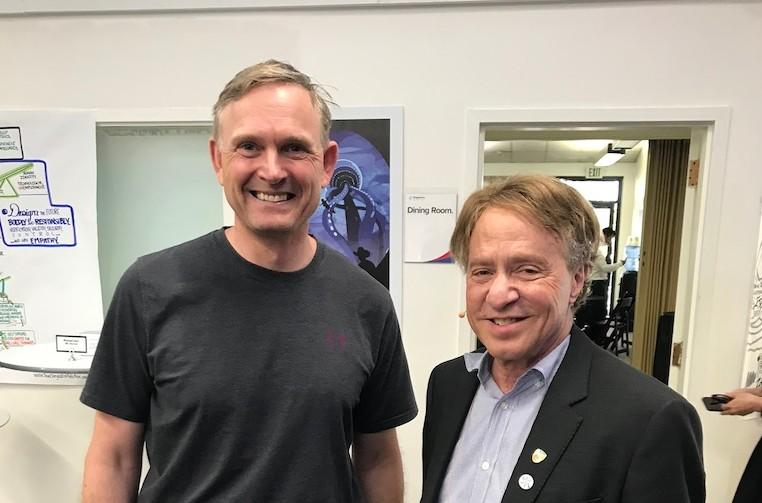World-Class Excellence Stems from Individual Freedom
The model of a free, democratic society is currently in crisis. Better leadership and digital transformation can provide relief.
How is it possible to overcome the current crisis facing the model of a free, democratic society? By dramatically increasing our productivity. Dramatic does not mean by two, three, or even five percent, but by at least doubling it. A radical shift—a "V-Change Transformation"—is necessary. Two essential factors can make this happen:
• Outstanding Leadership
• and Digital Transformation
Outstanding Leadership
The essence of leadership is to unleash the best within people. It means addressing individuals according to their unique needs, thereby generating maximum intrinsic motivation. This aim of releasing such motivation applies equally to education, teaching, employee management, and political leadership.
Currently, there is significant potential for improvement in this regard. By this, I mean that leadership in the areas mentioned still often operates on the outdated assumption that society and its organizations must be structured hierarchically. A few leaders at the top dictate what many on the lower levels must do.
However, this model is no longer suitable for solving today's challenges, as it is based on a static worldview with limited resources. It mistakenly assumes that the people on earth are limited to a finite set of resources, making distribution a zero-sum game. In other words: what one person has more of, another has less of. The stronger person has more; the weaker has less. The stronger one stands at the top, while the weaker one is at the bottom of the societal hierarchy. Strength and weakness here are partly defined by human qualities with which one is born. In ancient times, physical strength was extremely important, which is why, for example, men tended to dominate over women. With the replacement of muscle power by machine power in the industrialization era, intellect (as measured by IQ) gained overriding importance in the hierarchy of human qualities.
Measured intelligence is still the most decisive factor for academic, professional, and financial success. A small group of people with the highest measured IQ stands at the top of society, directing a larger group of less intelligent people on what to do. This societal model, which produced excellent results over a long time, has now reached the limits of its possibilities and no longer functions properly. That’s why we are currently experiencing a leadership crisis, reflected in political apathy, declining voter turnout, and increased support for populist parties. Insufficient willingness to perform, internal resignation, and burnout are further consequences.
This came about because the traditional hierarchical leadership model is no longer capable of handling the complexity of the modern world. Hierarchical leadership presumes that “those at the top” are indeed better informed in all relevant matters and thus able to provide competent instructions to “those at the bottom.”
This worked in earlier times—for example, in commanding large armies in the 19th century or managing large corporations in the early 20th century. But a highly complex organization of the 21st century can no longer be directed through “instructions from above.” Its functioning increasingly depends on highly competent specialists who master their individual fields. Just mastering the information technology of a modern large organization today requires an army of specialists that no single person can direct with orders alone. Instead, a leader must be able to orchestrate the work of these specialists so that their collaboration achieves the best possible overall result. In this context, the leader does not stand above the specialists.
Leadership—or orchestration—is just one of several special tasks within a team. This is comparable to the role of a coach of a football team. Their job is to bring out each player’s specific strengths so that the team as a whole achieves the best possible result. In such a setup, there is no “above” or “below.” There are only “necessary special skills.” A good football team includes a good coach just as it includes a good defender or striker. Each person contributes their part to the functioning of the larger whole. Everyone operates on an equal footing.
The world of the 21st century is increasingly becoming a world of specialists. This process is accelerating at an exponential rate. We can see this clearly in the rapid growth of human knowledge: while it took 50 years to double knowledge in 1950, it took only seven years in 1980 and just four years in 2010. In the current decade, human knowledge doubles every 73 days.
This results in increasingly overwhelming complexity. Mastering this complexity is a collective task. Understanding important connections, making the right decisions, and implementing them effectively can only be achieved in teams. Hyper-complexity can only be understood and mastered through a versatile perspective and a multi-dimensional approach. Intelligence alone is no longer enough. Instead, we need every possible human talent.
Because the rapidly increasing pace of technological change forces people to adapt at the same speed, this is a collective mammoth task. Even companies have significant difficulties in changing their workforce and systems quickly enough. On a national level, this change is even more challenging by several orders of magnitude.
Successful change requires emotionally engaging people and guiding them through the process—and not just a select intellectual elite, but all people, with all their natural characteristics. Reaching only a small intellectual elite is no longer sufficient.
Rather, it is about reaching millions of people. This is why outstanding communication is so important today. It takes many specialists to implement this appropriately—such as graphic designers, event managers, writers, and people of integrity.
It takes an overall spirit of collective awakening and a sense in everyone that they are needed and can make an important individual contribution. As already stated, it depends on every person and every human talent. In this context, the motto of the book by Gerald Hüther and Uli Hauser applies: “Every child is highly gifted.”
Nearly everyone today is capable of making an outstanding contribution. Among other things, technological progress enables more and more people with disabilities to contribute their exceptional strengths. For instance, individuals on the autism spectrum, who often have a well-developed talent for thinking in geometric patterns, equations, and colors, can use these abilities to help develop computer programs or detect errors in complex structures. The often enhanced tactile and auditory senses of blind people are beneficial for tuning pianos, providing massages, and early detection of breast cancer. Deaf people, who frequently have a heightened capacity for long-term concentration and an excellent spatial sense, also bring valuable skills.
It is the task of good leadership to discover these talents within people and bring them to full bloom. More precisely, good leadership must guide people in discovering their talents within themselves and understanding how to put them to use.
Education and training must primarily serve to help children discover and appreciate their unique talents, continually elevating their development. Ultimately, this should lead to everyone working in precisely the area where they:
• possess outstanding competence,
• have an overwhelming passion,
• and meet an urgent need of others (such as customers).
At first glance, this demand may seem dauntingly high. But it essentially means: “Do the best you can with what you are and what you have.” For me, this is the very purpose of life: to provide our fellow human beings with our best possible service.
“The secret of life is giving,” says American coaching legend Tony Robbins. I believe there’s nothing to add to that.
The society of the future consists of networks of excellently orchestrated specialists who complement each other in their specific strengths, creating synergies—Win-Win situations.
These synergies mean that the world is no longer a zero-sum game, as new, additional value is continuously created. Things are created where nothing existed before, and at an astonishing pace.
Digital Transformation
This is where the aspect of digitalization comes into play. Networking people is one of its cornerstones, allowing individuals to focus exclusively on their core competencies and have everything else done by other specialists whose services can be purchased.
This leads to the widespread application of David Ricardo's theory of comparative cost advantage. Originally developed to describe the benefits of international trade relationships between nations, this theory states that the overall wealth of countries involved in trade increases disproportionately if each focuses on producing goods they can produce most efficiently.
Ricardo's theory applies equally to the exchange of goods and services between companies and individuals. When everyone focuses on what they do best and exchanges these services with others, the overall wealth for all increases disproportionately.
Applied globally, the productivity increase and the corresponding potential for wealth growth for humanity as a whole are enormous. Besides enabling human networking, digitalization provides another tremendous advantage: the possibility of maximally precise process control. Digitally controlled processes take over repetitive tasks that people, by nature, are not designed to perform consistently, 24/7, at a high standard. Computers, on the other hand, excel at this discipline. Therefore, we should assign them as many processes as possible. Achieving this requires four preconditions:
• Capturing information in a digital format
• Fully understanding processes and the information necessary for their execution
• Agreeing on standard processes
• Implementing these standard processes across all involved parties
This may sound simple. But why, then, do organizations in both the private sector and public administration find it so challenging to implement these points? There are two reasons:
1. Most organizations are not properly structured for the digitalization process.
Organizations are usually organized by departments, but workflows often cross departmental boundaries. Consequently, departments must collaborate to digitalize processes. This is labor-intensive, and voluntary willingness to do so is often lacking. In most organizations, there is still no responsible person or department to orchestrate this collaboration. Such a department responsible for the data and process architecture of the entire organization must be established to coordinate cooperation across departments.
2. Digitalization requires a way of working that most employees are unaccustomed to and inadequately trained for.
Digitalization requires employees to understand workflows in detail from start to finish. They need to know precisely what information is required at each step for a process to function. This detailed, data-driven way of thinking needs to be learned, and it takes time.
These points illustrate why digitalization is a massive transformation project for any organization and society as a whole, demanding an enormous collective effort. Achieving this requires exceptional leadership, completing the circle. Outstanding leadership and digitalization are directly linked. They are the keys to a massive productivity leap in the free Western world.
Only a free society is capable of such a significant productivity leap because intrinsic motivation can only be fully unleashed in free individuals; it cannot be dictated. In this respect, we have a tremendous advantage over those enemies of democracy and freedom mentioned at the outset. Now we must mobilize this advantage with lightning speed.
We are all called upon to participate!
Defining and implementing your individual strategy to operate at a world class level
I founded the charity organization Run & Ride for Reading to support and promote the reading and learning ability of children. Reading and learning is the bedrock to lead a successful life and to operate at a world class level.
Profits generated through sales of products and services on this website are used to fund Run & Ride for Reading
Weltklasse
Achieving world-class excellence means aligning one’s greatest strengths with the most urgent needs they can fulfill.
Vortrag bei GEDANKENtanken









